Avian Influenza: Emerging Health Issue, Mitigation, and Nursing Role
VerifiedAdded on 2022/09/16
|11
|3285
|20
Essay
AI Summary
This essay delves into the topic of Avian Influenza, also known as bird flu, as an emerging global health issue. It begins with an introduction to the disease, caused by Avian Flu Type A viruses, and its potential to cause pandemics through mutation and human-to-human transmission. The essay then justifies the classification of Avian Influenza as an emerging health issue by examining the history of outbreaks, including the H5N1 and H7N9 strains, and the factors contributing to its spread, such as contact with infected birds, contaminated environments, and international travel. The essay further outlines and critiques various approaches to reduce and mitigate the infection, including the use of personal protective equipment, continuous surveillance, and the importance of proper cooking of poultry products. A significant portion of the essay focuses on the critical role of registered nurses in managing and preventing the spread of Avian Influenza, including patient care, diagnostic testing, treatment with antiviral drugs, and adherence to ethical guidelines. The essay emphasizes the challenges nurses face, such as personal risk and the need to balance professional and personal responsibilities, and highlights the importance of preparedness and continuous education in mitigating the impact of the disease. The essay concludes by underscoring the significance of the role of nursing staff in the diagnosis of the infection, treatment of the patients and preventing the spread of infection to others.
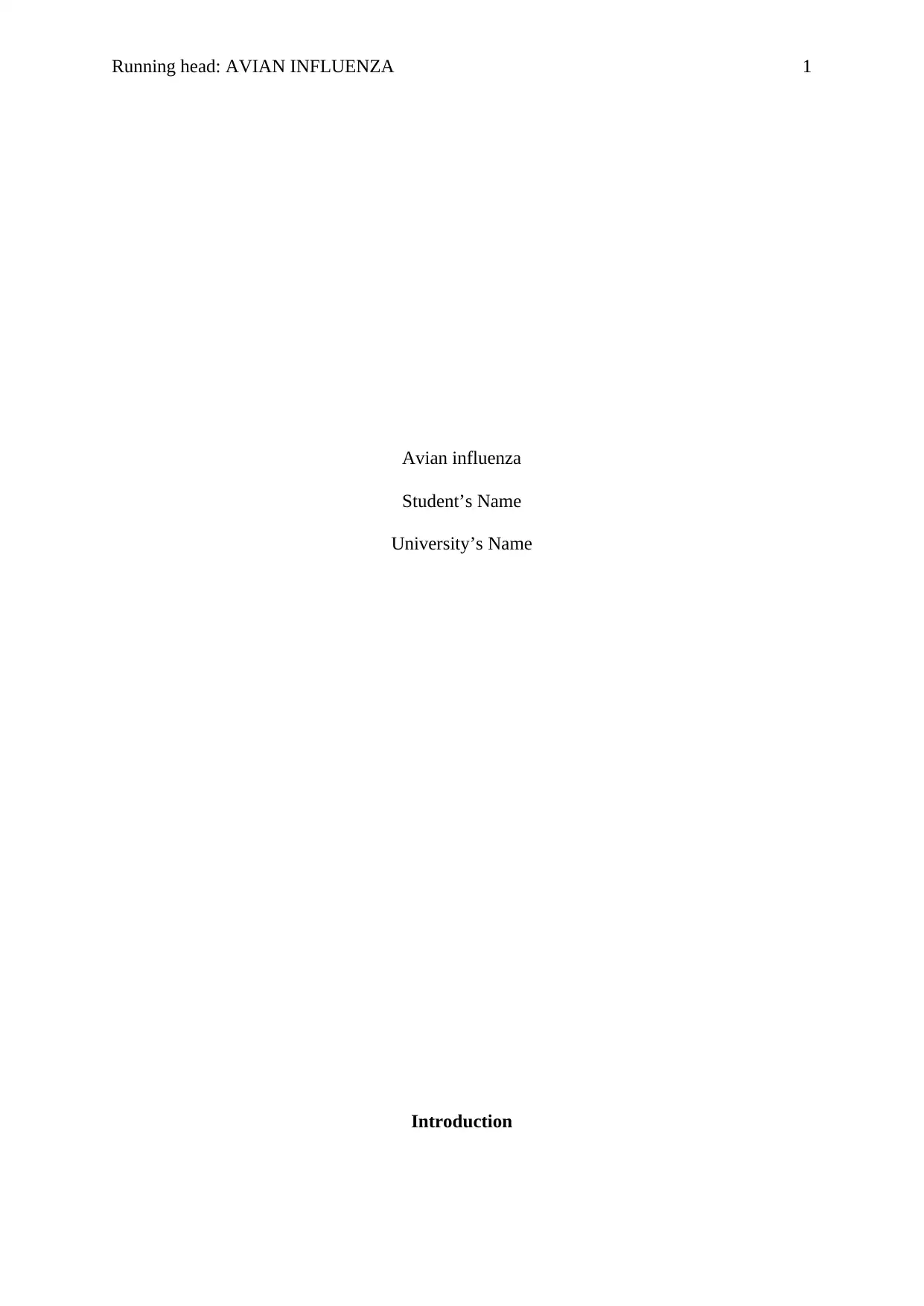
Running head: AVIAN INFLUENZA 1
Avian influenza
Student’s Name
University’s Name
Introduction
Avian influenza
Student’s Name
University’s Name
Introduction
Paraphrase This Document
Need a fresh take? Get an instant paraphrase of this document with our AI Paraphraser
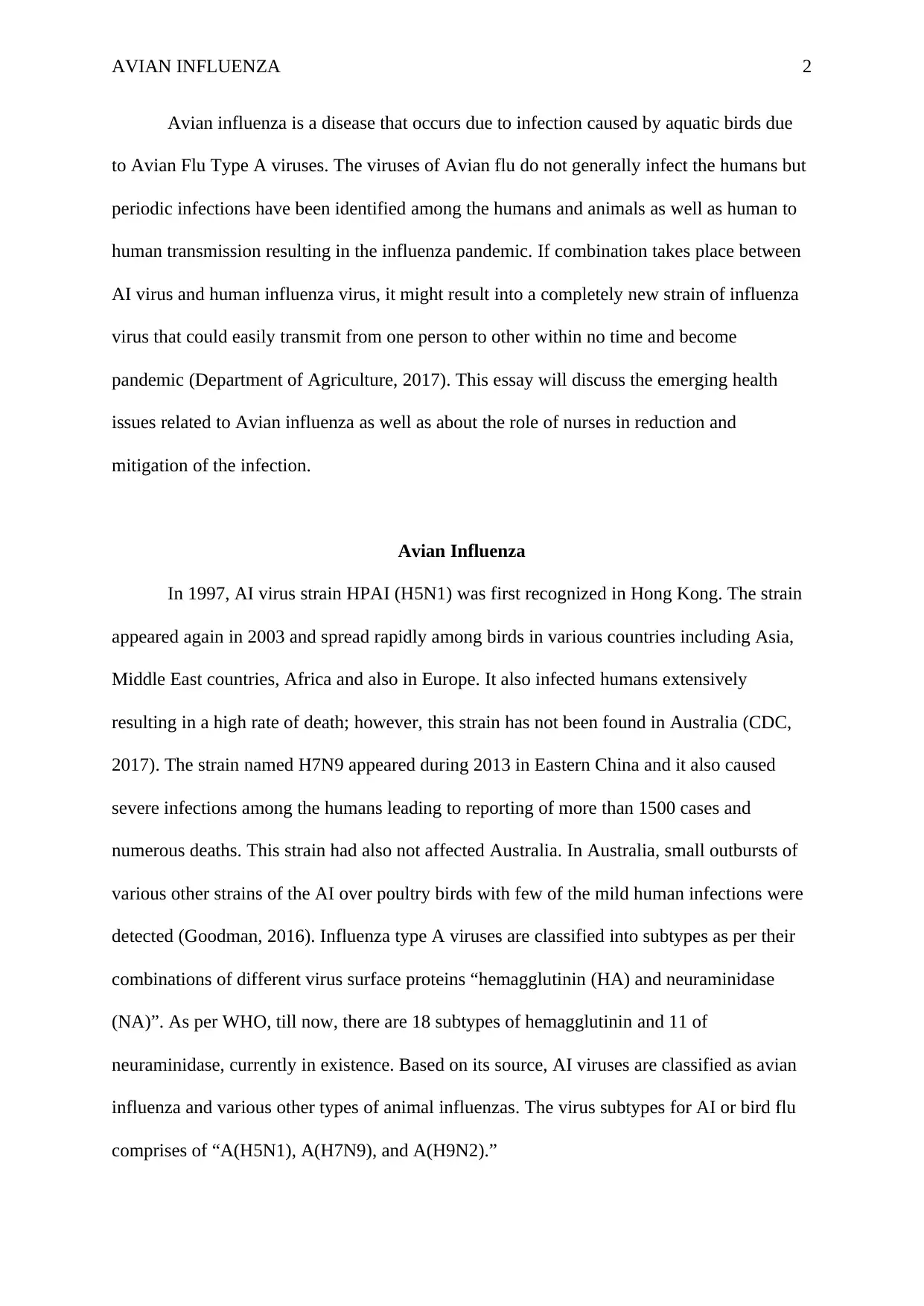
AVIAN INFLUENZA 2
Avian influenza is a disease that occurs due to infection caused by aquatic birds due
to Avian Flu Type A viruses. The viruses of Avian flu do not generally infect the humans but
periodic infections have been identified among the humans and animals as well as human to
human transmission resulting in the influenza pandemic. If combination takes place between
AI virus and human influenza virus, it might result into a completely new strain of influenza
virus that could easily transmit from one person to other within no time and become
pandemic (Department of Agriculture, 2017). This essay will discuss the emerging health
issues related to Avian influenza as well as about the role of nurses in reduction and
mitigation of the infection.
Avian Influenza
In 1997, AI virus strain HPAI (H5N1) was first recognized in Hong Kong. The strain
appeared again in 2003 and spread rapidly among birds in various countries including Asia,
Middle East countries, Africa and also in Europe. It also infected humans extensively
resulting in a high rate of death; however, this strain has not been found in Australia (CDC,
2017). The strain named H7N9 appeared during 2013 in Eastern China and it also caused
severe infections among the humans leading to reporting of more than 1500 cases and
numerous deaths. This strain had also not affected Australia. In Australia, small outbursts of
various other strains of the AI over poultry birds with few of the mild human infections were
detected (Goodman, 2016). Influenza type A viruses are classified into subtypes as per their
combinations of different virus surface proteins “hemagglutinin (HA) and neuraminidase
(NA)”. As per WHO, till now, there are 18 subtypes of hemagglutinin and 11 of
neuraminidase, currently in existence. Based on its source, AI viruses are classified as avian
influenza and various other types of animal influenzas. The virus subtypes for AI or bird flu
comprises of “A(H5N1), A(H7N9), and A(H9N2).”
Avian influenza is a disease that occurs due to infection caused by aquatic birds due
to Avian Flu Type A viruses. The viruses of Avian flu do not generally infect the humans but
periodic infections have been identified among the humans and animals as well as human to
human transmission resulting in the influenza pandemic. If combination takes place between
AI virus and human influenza virus, it might result into a completely new strain of influenza
virus that could easily transmit from one person to other within no time and become
pandemic (Department of Agriculture, 2017). This essay will discuss the emerging health
issues related to Avian influenza as well as about the role of nurses in reduction and
mitigation of the infection.
Avian Influenza
In 1997, AI virus strain HPAI (H5N1) was first recognized in Hong Kong. The strain
appeared again in 2003 and spread rapidly among birds in various countries including Asia,
Middle East countries, Africa and also in Europe. It also infected humans extensively
resulting in a high rate of death; however, this strain has not been found in Australia (CDC,
2017). The strain named H7N9 appeared during 2013 in Eastern China and it also caused
severe infections among the humans leading to reporting of more than 1500 cases and
numerous deaths. This strain had also not affected Australia. In Australia, small outbursts of
various other strains of the AI over poultry birds with few of the mild human infections were
detected (Goodman, 2016). Influenza type A viruses are classified into subtypes as per their
combinations of different virus surface proteins “hemagglutinin (HA) and neuraminidase
(NA)”. As per WHO, till now, there are 18 subtypes of hemagglutinin and 11 of
neuraminidase, currently in existence. Based on its source, AI viruses are classified as avian
influenza and various other types of animal influenzas. The virus subtypes for AI or bird flu
comprises of “A(H5N1), A(H7N9), and A(H9N2).”
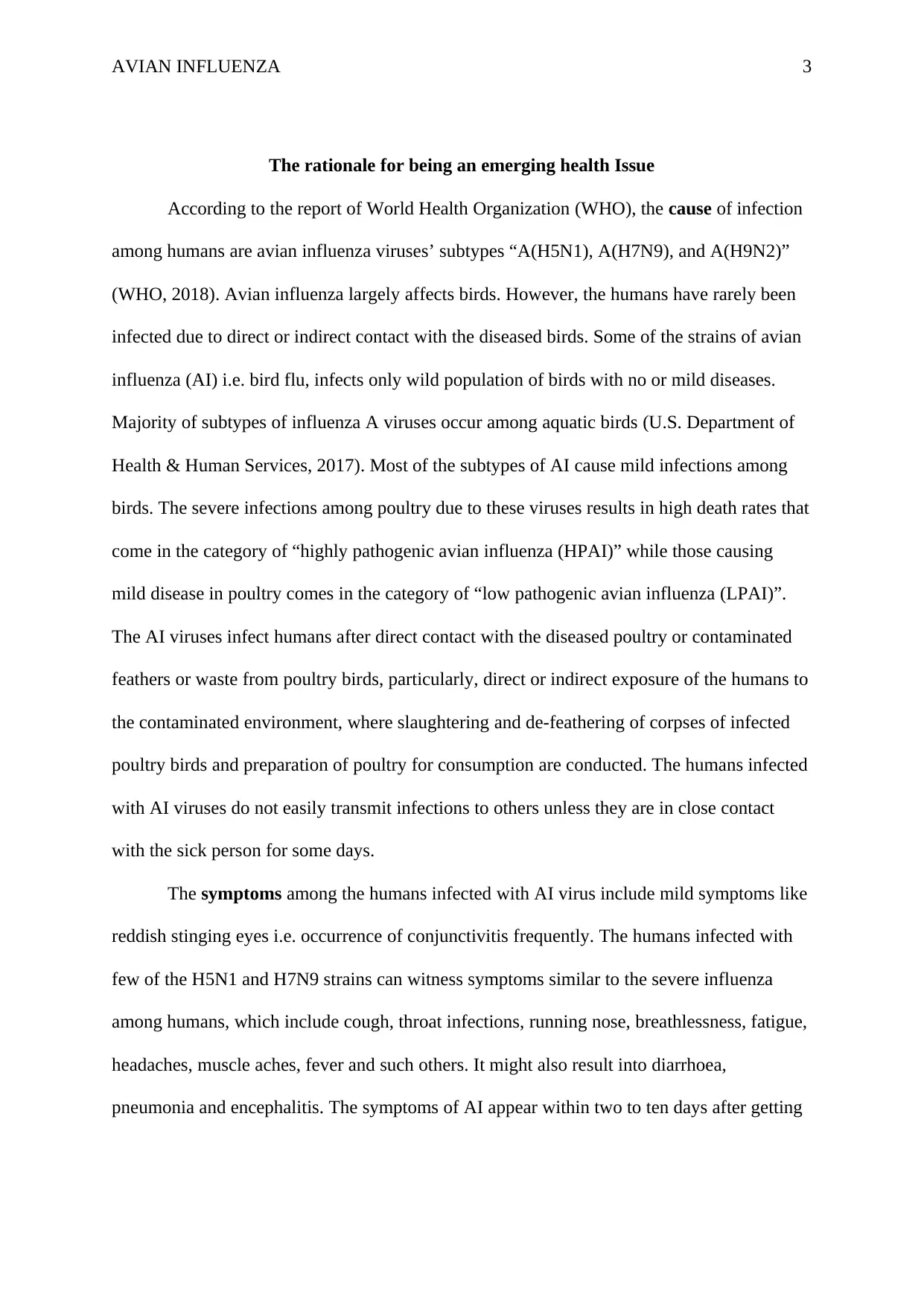
AVIAN INFLUENZA 3
The rationale for being an emerging health Issue
According to the report of World Health Organization (WHO), the cause of infection
among humans are avian influenza viruses’ subtypes “A(H5N1), A(H7N9), and A(H9N2)”
(WHO, 2018). Avian influenza largely affects birds. However, the humans have rarely been
infected due to direct or indirect contact with the diseased birds. Some of the strains of avian
influenza (AI) i.e. bird flu, infects only wild population of birds with no or mild diseases.
Majority of subtypes of influenza A viruses occur among aquatic birds (U.S. Department of
Health & Human Services, 2017). Most of the subtypes of AI cause mild infections among
birds. The severe infections among poultry due to these viruses results in high death rates that
come in the category of “highly pathogenic avian influenza (HPAI)” while those causing
mild disease in poultry comes in the category of “low pathogenic avian influenza (LPAI)”.
The AI viruses infect humans after direct contact with the diseased poultry or contaminated
feathers or waste from poultry birds, particularly, direct or indirect exposure of the humans to
the contaminated environment, where slaughtering and de-feathering of corpses of infected
poultry birds and preparation of poultry for consumption are conducted. The humans infected
with AI viruses do not easily transmit infections to others unless they are in close contact
with the sick person for some days.
The symptoms among the humans infected with AI virus include mild symptoms like
reddish stinging eyes i.e. occurrence of conjunctivitis frequently. The humans infected with
few of the H5N1 and H7N9 strains can witness symptoms similar to the severe influenza
among humans, which include cough, throat infections, running nose, breathlessness, fatigue,
headaches, muscle aches, fever and such others. It might also result into diarrhoea,
pneumonia and encephalitis. The symptoms of AI appear within two to ten days after getting
The rationale for being an emerging health Issue
According to the report of World Health Organization (WHO), the cause of infection
among humans are avian influenza viruses’ subtypes “A(H5N1), A(H7N9), and A(H9N2)”
(WHO, 2018). Avian influenza largely affects birds. However, the humans have rarely been
infected due to direct or indirect contact with the diseased birds. Some of the strains of avian
influenza (AI) i.e. bird flu, infects only wild population of birds with no or mild diseases.
Majority of subtypes of influenza A viruses occur among aquatic birds (U.S. Department of
Health & Human Services, 2017). Most of the subtypes of AI cause mild infections among
birds. The severe infections among poultry due to these viruses results in high death rates that
come in the category of “highly pathogenic avian influenza (HPAI)” while those causing
mild disease in poultry comes in the category of “low pathogenic avian influenza (LPAI)”.
The AI viruses infect humans after direct contact with the diseased poultry or contaminated
feathers or waste from poultry birds, particularly, direct or indirect exposure of the humans to
the contaminated environment, where slaughtering and de-feathering of corpses of infected
poultry birds and preparation of poultry for consumption are conducted. The humans infected
with AI viruses do not easily transmit infections to others unless they are in close contact
with the sick person for some days.
The symptoms among the humans infected with AI virus include mild symptoms like
reddish stinging eyes i.e. occurrence of conjunctivitis frequently. The humans infected with
few of the H5N1 and H7N9 strains can witness symptoms similar to the severe influenza
among humans, which include cough, throat infections, running nose, breathlessness, fatigue,
headaches, muscle aches, fever and such others. It might also result into diarrhoea,
pneumonia and encephalitis. The symptoms of AI appear within two to ten days after getting
⊘ This is a preview!⊘
Do you want full access?
Subscribe today to unlock all pages.

Trusted by 1+ million students worldwide

AVIAN INFLUENZA 4
exposed to the infected birds and lasts up to seven days. The people infected with AI remain
infectious for a minimum of 7 days and infections lasts among children for up to 21 days.
The AI infection is an emerging issue because there is no specific human vaccine
available for the prevention of disease. However, the use of anti-influenza medication and
other infection control strategies might also prove to be effective in controlling the spread of
infection among the caretakers of the infected person. The vaccination of the seasonal
influenza vaccine is highly recommended to the people. Furthermore, in laboratories, where
the specimens of the infected patients are handled by the lab workers, they are also advised to
follow specific safety requirements (Tzeng & Yin, 2016). The humans travelling to regions
affected by AI could easily get affected if precautionary measures are not taken by them
(NSW Government, 2016). Even after releasing health advisory related to avoiding travelling
to the areas affected with AI viruses, the advices are not taken seriously by the travellers. It
results in spread of the infection from one country to other, Similarly, due to the use and
export of infected poultry products, the probability of quick infection increases. In order to
prevent the emergence of AI in Australia, people infected with AI are not allowed to enter
Australia transmit it to others. As a strict precautionary measure, the people arriving in
Australia from the countries reporting cases of AI infections are monitored for their health
conditions for at least seven days as well as for other respiratory issues and the period of
monitoring might extend as well. It is the reason due to which, AI has become an emerging
health issue as it has the potential to take the form of influenza pandemic as a result of
negligence since its inception.
Approaches and RN role to reduce or mitigate infection
The role of registered nurses (RN) is considered as highly significant in mitigating the
impact of AI infection among humans. On one hand, it becomes their foremost duty to take
exposed to the infected birds and lasts up to seven days. The people infected with AI remain
infectious for a minimum of 7 days and infections lasts among children for up to 21 days.
The AI infection is an emerging issue because there is no specific human vaccine
available for the prevention of disease. However, the use of anti-influenza medication and
other infection control strategies might also prove to be effective in controlling the spread of
infection among the caretakers of the infected person. The vaccination of the seasonal
influenza vaccine is highly recommended to the people. Furthermore, in laboratories, where
the specimens of the infected patients are handled by the lab workers, they are also advised to
follow specific safety requirements (Tzeng & Yin, 2016). The humans travelling to regions
affected by AI could easily get affected if precautionary measures are not taken by them
(NSW Government, 2016). Even after releasing health advisory related to avoiding travelling
to the areas affected with AI viruses, the advices are not taken seriously by the travellers. It
results in spread of the infection from one country to other, Similarly, due to the use and
export of infected poultry products, the probability of quick infection increases. In order to
prevent the emergence of AI in Australia, people infected with AI are not allowed to enter
Australia transmit it to others. As a strict precautionary measure, the people arriving in
Australia from the countries reporting cases of AI infections are monitored for their health
conditions for at least seven days as well as for other respiratory issues and the period of
monitoring might extend as well. It is the reason due to which, AI has become an emerging
health issue as it has the potential to take the form of influenza pandemic as a result of
negligence since its inception.
Approaches and RN role to reduce or mitigate infection
The role of registered nurses (RN) is considered as highly significant in mitigating the
impact of AI infection among humans. On one hand, it becomes their foremost duty to take
Paraphrase This Document
Need a fresh take? Get an instant paraphrase of this document with our AI Paraphraser
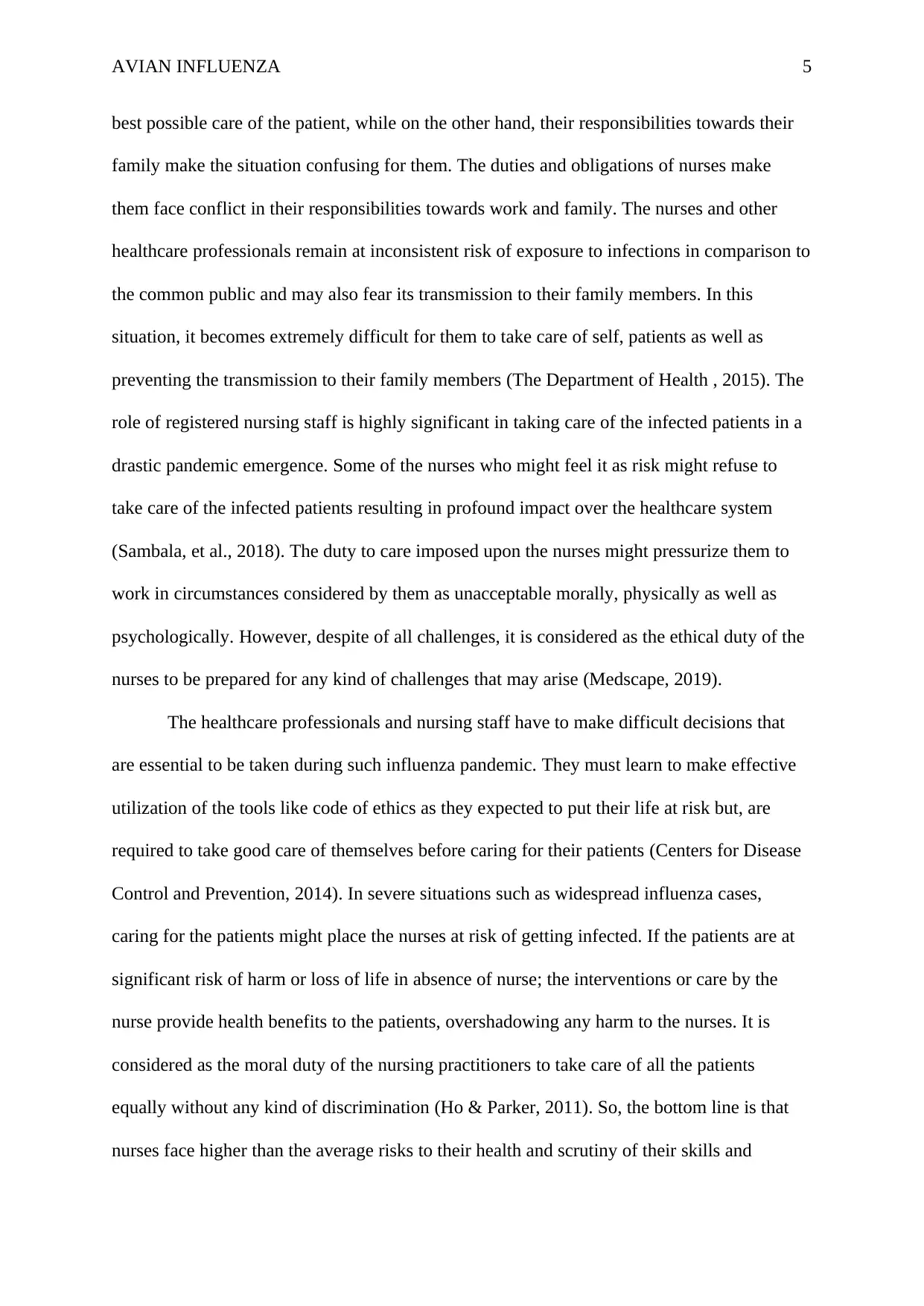
AVIAN INFLUENZA 5
best possible care of the patient, while on the other hand, their responsibilities towards their
family make the situation confusing for them. The duties and obligations of nurses make
them face conflict in their responsibilities towards work and family. The nurses and other
healthcare professionals remain at inconsistent risk of exposure to infections in comparison to
the common public and may also fear its transmission to their family members. In this
situation, it becomes extremely difficult for them to take care of self, patients as well as
preventing the transmission to their family members (The Department of Health , 2015). The
role of registered nursing staff is highly significant in taking care of the infected patients in a
drastic pandemic emergence. Some of the nurses who might feel it as risk might refuse to
take care of the infected patients resulting in profound impact over the healthcare system
(Sambala, et al., 2018). The duty to care imposed upon the nurses might pressurize them to
work in circumstances considered by them as unacceptable morally, physically as well as
psychologically. However, despite of all challenges, it is considered as the ethical duty of the
nurses to be prepared for any kind of challenges that may arise (Medscape, 2019).
The healthcare professionals and nursing staff have to make difficult decisions that
are essential to be taken during such influenza pandemic. They must learn to make effective
utilization of the tools like code of ethics as they expected to put their life at risk but, are
required to take good care of themselves before caring for their patients (Centers for Disease
Control and Prevention, 2014). In severe situations such as widespread influenza cases,
caring for the patients might place the nurses at risk of getting infected. If the patients are at
significant risk of harm or loss of life in absence of nurse; the interventions or care by the
nurse provide health benefits to the patients, overshadowing any harm to the nurses. It is
considered as the moral duty of the nursing practitioners to take care of all the patients
equally without any kind of discrimination (Ho & Parker, 2011). So, the bottom line is that
nurses face higher than the average risks to their health and scrutiny of their skills and
best possible care of the patient, while on the other hand, their responsibilities towards their
family make the situation confusing for them. The duties and obligations of nurses make
them face conflict in their responsibilities towards work and family. The nurses and other
healthcare professionals remain at inconsistent risk of exposure to infections in comparison to
the common public and may also fear its transmission to their family members. In this
situation, it becomes extremely difficult for them to take care of self, patients as well as
preventing the transmission to their family members (The Department of Health , 2015). The
role of registered nursing staff is highly significant in taking care of the infected patients in a
drastic pandemic emergence. Some of the nurses who might feel it as risk might refuse to
take care of the infected patients resulting in profound impact over the healthcare system
(Sambala, et al., 2018). The duty to care imposed upon the nurses might pressurize them to
work in circumstances considered by them as unacceptable morally, physically as well as
psychologically. However, despite of all challenges, it is considered as the ethical duty of the
nurses to be prepared for any kind of challenges that may arise (Medscape, 2019).
The healthcare professionals and nursing staff have to make difficult decisions that
are essential to be taken during such influenza pandemic. They must learn to make effective
utilization of the tools like code of ethics as they expected to put their life at risk but, are
required to take good care of themselves before caring for their patients (Centers for Disease
Control and Prevention, 2014). In severe situations such as widespread influenza cases,
caring for the patients might place the nurses at risk of getting infected. If the patients are at
significant risk of harm or loss of life in absence of nurse; the interventions or care by the
nurse provide health benefits to the patients, overshadowing any harm to the nurses. It is
considered as the moral duty of the nursing practitioners to take care of all the patients
equally without any kind of discrimination (Ho & Parker, 2011). So, the bottom line is that
nurses face higher than the average risks to their health and scrutiny of their skills and

AVIAN INFLUENZA 6
expertise and their professional commitments during influenza pandemic. To ensure
minimization of risks, it is expected from the nurses to follow professional code of ethics, to
become educated and to make pre-pandemic planning within the healthcare organization
(Sokol, 2018).
The role of nursing staff is considered as significant in diagnosis of the infection
caused due to AI virus among humans. The diagnostic tests are conducted on the samples of
swabs taken from the nose and throat of the infected persons. Various laboratory tests are
conducted to diagnose the infection of this zoonotic influenza among humans (Horvath,
McKinnon, & Roberts, 2016). As AI is a globally emerging health issues, “Global Influenza
Surveillance and Response System (GISRS)” of WHO, keep on upgrading technical guidance
protocols utilized for detection of this virus among humans through molecular RT-PCR and
such others methods (World Health Organization, 2015). The sensitivity of the “Rapid
influenza diagnostic tests (RIDTs)” is less than other PCR techniques and their
trustworthiness relies upon the conditions in which they are being utilized. The RDTs that are
available commercially, cannot provide information about the subtype and are occasionally
utilized in clinical backgrounds, but, the utilization of these diagnostic tests in the process of
detection of zoonotic viruses is restricted (Ho & Parker, 2011). The acceptable and suitable
samples of swabs for influenza tests need to be taken from the infected persons and should be
processed with diagnostics in accordance with the relevant guidelines and protocols. The
healthcare professionals need to be highly cautious in handling the samples of the patients to
reduce the probability of infection among others.
The role of nursing staff in treating the patients suffering from AI infection and to
prevent the infection from getting transferred to others, is also highly significant. For
treatment of infections caused due to AI viruses in humans, specific antiviral drugs are
predicted to be effective, which is why these drugs are used to treat infected humans. The
expertise and their professional commitments during influenza pandemic. To ensure
minimization of risks, it is expected from the nurses to follow professional code of ethics, to
become educated and to make pre-pandemic planning within the healthcare organization
(Sokol, 2018).
The role of nursing staff is considered as significant in diagnosis of the infection
caused due to AI virus among humans. The diagnostic tests are conducted on the samples of
swabs taken from the nose and throat of the infected persons. Various laboratory tests are
conducted to diagnose the infection of this zoonotic influenza among humans (Horvath,
McKinnon, & Roberts, 2016). As AI is a globally emerging health issues, “Global Influenza
Surveillance and Response System (GISRS)” of WHO, keep on upgrading technical guidance
protocols utilized for detection of this virus among humans through molecular RT-PCR and
such others methods (World Health Organization, 2015). The sensitivity of the “Rapid
influenza diagnostic tests (RIDTs)” is less than other PCR techniques and their
trustworthiness relies upon the conditions in which they are being utilized. The RDTs that are
available commercially, cannot provide information about the subtype and are occasionally
utilized in clinical backgrounds, but, the utilization of these diagnostic tests in the process of
detection of zoonotic viruses is restricted (Ho & Parker, 2011). The acceptable and suitable
samples of swabs for influenza tests need to be taken from the infected persons and should be
processed with diagnostics in accordance with the relevant guidelines and protocols. The
healthcare professionals need to be highly cautious in handling the samples of the patients to
reduce the probability of infection among others.
The role of nursing staff in treating the patients suffering from AI infection and to
prevent the infection from getting transferred to others, is also highly significant. For
treatment of infections caused due to AI viruses in humans, specific antiviral drugs are
predicted to be effective, which is why these drugs are used to treat infected humans. The
⊘ This is a preview!⊘
Do you want full access?
Subscribe today to unlock all pages.

Trusted by 1+ million students worldwide
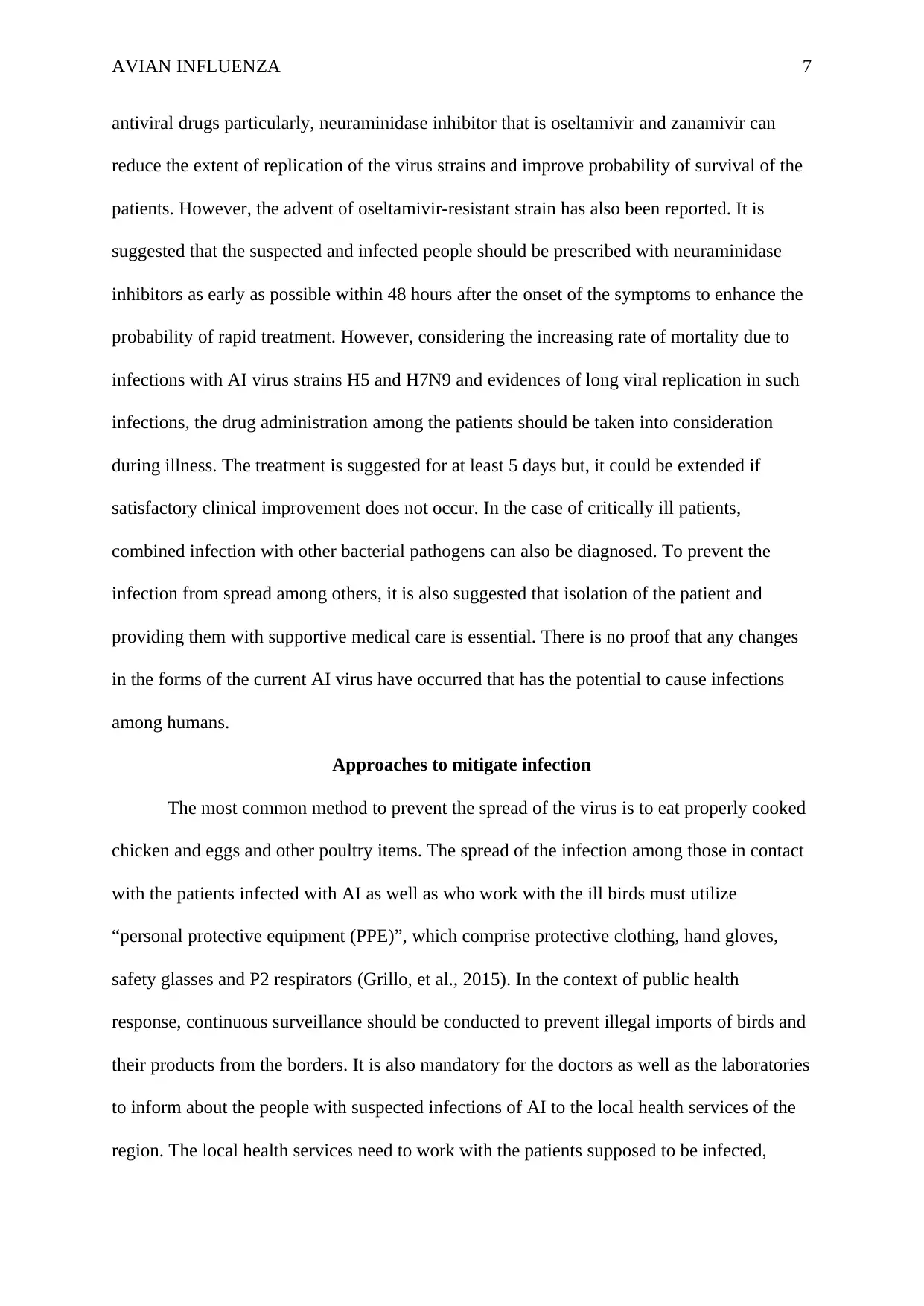
AVIAN INFLUENZA 7
antiviral drugs particularly, neuraminidase inhibitor that is oseltamivir and zanamivir can
reduce the extent of replication of the virus strains and improve probability of survival of the
patients. However, the advent of oseltamivir-resistant strain has also been reported. It is
suggested that the suspected and infected people should be prescribed with neuraminidase
inhibitors as early as possible within 48 hours after the onset of the symptoms to enhance the
probability of rapid treatment. However, considering the increasing rate of mortality due to
infections with AI virus strains H5 and H7N9 and evidences of long viral replication in such
infections, the drug administration among the patients should be taken into consideration
during illness. The treatment is suggested for at least 5 days but, it could be extended if
satisfactory clinical improvement does not occur. In the case of critically ill patients,
combined infection with other bacterial pathogens can also be diagnosed. To prevent the
infection from spread among others, it is also suggested that isolation of the patient and
providing them with supportive medical care is essential. There is no proof that any changes
in the forms of the current AI virus have occurred that has the potential to cause infections
among humans.
Approaches to mitigate infection
The most common method to prevent the spread of the virus is to eat properly cooked
chicken and eggs and other poultry items. The spread of the infection among those in contact
with the patients infected with AI as well as who work with the ill birds must utilize
“personal protective equipment (PPE)”, which comprise protective clothing, hand gloves,
safety glasses and P2 respirators (Grillo, et al., 2015). In the context of public health
response, continuous surveillance should be conducted to prevent illegal imports of birds and
their products from the borders. It is also mandatory for the doctors as well as the laboratories
to inform about the people with suspected infections of AI to the local health services of the
region. The local health services need to work with the patients supposed to be infected,
antiviral drugs particularly, neuraminidase inhibitor that is oseltamivir and zanamivir can
reduce the extent of replication of the virus strains and improve probability of survival of the
patients. However, the advent of oseltamivir-resistant strain has also been reported. It is
suggested that the suspected and infected people should be prescribed with neuraminidase
inhibitors as early as possible within 48 hours after the onset of the symptoms to enhance the
probability of rapid treatment. However, considering the increasing rate of mortality due to
infections with AI virus strains H5 and H7N9 and evidences of long viral replication in such
infections, the drug administration among the patients should be taken into consideration
during illness. The treatment is suggested for at least 5 days but, it could be extended if
satisfactory clinical improvement does not occur. In the case of critically ill patients,
combined infection with other bacterial pathogens can also be diagnosed. To prevent the
infection from spread among others, it is also suggested that isolation of the patient and
providing them with supportive medical care is essential. There is no proof that any changes
in the forms of the current AI virus have occurred that has the potential to cause infections
among humans.
Approaches to mitigate infection
The most common method to prevent the spread of the virus is to eat properly cooked
chicken and eggs and other poultry items. The spread of the infection among those in contact
with the patients infected with AI as well as who work with the ill birds must utilize
“personal protective equipment (PPE)”, which comprise protective clothing, hand gloves,
safety glasses and P2 respirators (Grillo, et al., 2015). In the context of public health
response, continuous surveillance should be conducted to prevent illegal imports of birds and
their products from the borders. It is also mandatory for the doctors as well as the laboratories
to inform about the people with suspected infections of AI to the local health services of the
region. The local health services need to work with the patients supposed to be infected,
Paraphrase This Document
Need a fresh take? Get an instant paraphrase of this document with our AI Paraphraser
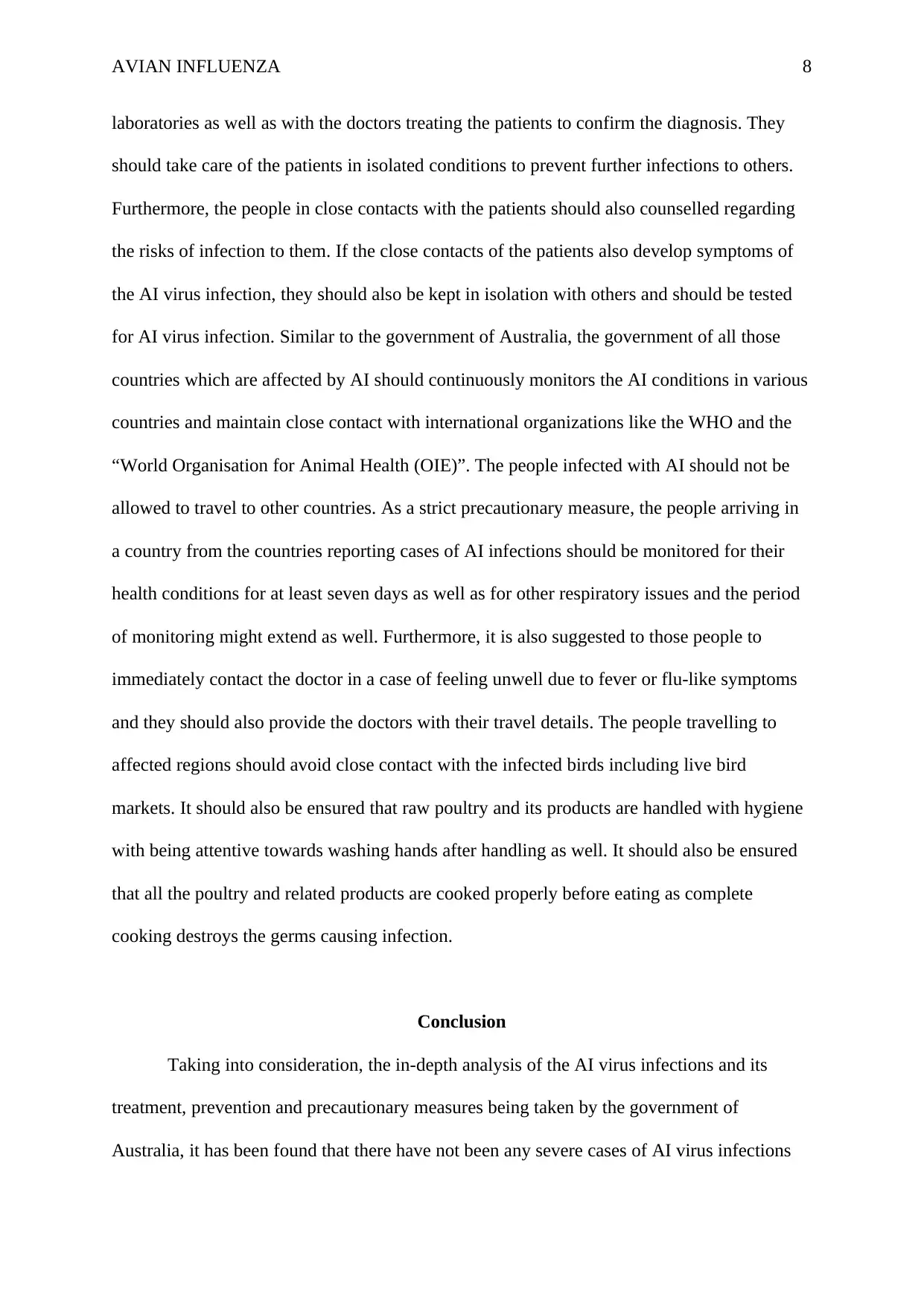
AVIAN INFLUENZA 8
laboratories as well as with the doctors treating the patients to confirm the diagnosis. They
should take care of the patients in isolated conditions to prevent further infections to others.
Furthermore, the people in close contacts with the patients should also counselled regarding
the risks of infection to them. If the close contacts of the patients also develop symptoms of
the AI virus infection, they should also be kept in isolation with others and should be tested
for AI virus infection. Similar to the government of Australia, the government of all those
countries which are affected by AI should continuously monitors the AI conditions in various
countries and maintain close contact with international organizations like the WHO and the
“World Organisation for Animal Health (OIE)”. The people infected with AI should not be
allowed to travel to other countries. As a strict precautionary measure, the people arriving in
a country from the countries reporting cases of AI infections should be monitored for their
health conditions for at least seven days as well as for other respiratory issues and the period
of monitoring might extend as well. Furthermore, it is also suggested to those people to
immediately contact the doctor in a case of feeling unwell due to fever or flu-like symptoms
and they should also provide the doctors with their travel details. The people travelling to
affected regions should avoid close contact with the infected birds including live bird
markets. It should also be ensured that raw poultry and its products are handled with hygiene
with being attentive towards washing hands after handling as well. It should also be ensured
that all the poultry and related products are cooked properly before eating as complete
cooking destroys the germs causing infection.
Conclusion
Taking into consideration, the in-depth analysis of the AI virus infections and its
treatment, prevention and precautionary measures being taken by the government of
Australia, it has been found that there have not been any severe cases of AI virus infections
laboratories as well as with the doctors treating the patients to confirm the diagnosis. They
should take care of the patients in isolated conditions to prevent further infections to others.
Furthermore, the people in close contacts with the patients should also counselled regarding
the risks of infection to them. If the close contacts of the patients also develop symptoms of
the AI virus infection, they should also be kept in isolation with others and should be tested
for AI virus infection. Similar to the government of Australia, the government of all those
countries which are affected by AI should continuously monitors the AI conditions in various
countries and maintain close contact with international organizations like the WHO and the
“World Organisation for Animal Health (OIE)”. The people infected with AI should not be
allowed to travel to other countries. As a strict precautionary measure, the people arriving in
a country from the countries reporting cases of AI infections should be monitored for their
health conditions for at least seven days as well as for other respiratory issues and the period
of monitoring might extend as well. Furthermore, it is also suggested to those people to
immediately contact the doctor in a case of feeling unwell due to fever or flu-like symptoms
and they should also provide the doctors with their travel details. The people travelling to
affected regions should avoid close contact with the infected birds including live bird
markets. It should also be ensured that raw poultry and its products are handled with hygiene
with being attentive towards washing hands after handling as well. It should also be ensured
that all the poultry and related products are cooked properly before eating as complete
cooking destroys the germs causing infection.
Conclusion
Taking into consideration, the in-depth analysis of the AI virus infections and its
treatment, prevention and precautionary measures being taken by the government of
Australia, it has been found that there have not been any severe cases of AI virus infections

AVIAN INFLUENZA 9
notified in Australia. The main reason behind this is the strict precautionary measures taken
by the healthcare authorities of Australia. As AI is an emerging viral infection all across the
world, it is essential for other countries to take preventive measures to protect their
population from AI infections. The role of RNs has been found to be highly significant in
diagnosis, treatment and prevention of AI infections among people. The nursing staff should
always remain prepared to handle the patients on immediate basis and to prevent infections
among others.
References
CDC. (2017). Information on Avian Influenza. Retrieved from Cdc.gov:
https://www.cdc.gov/flu/avianflu/index.htm
Centers for Disease Control and Prevention. (2014). Interim recommendations for infection
control in health-care facilities caring for patients with known or suspected avian
influenza. Retrieved from Cdc.gov: http://www.cdc.gov/flu/avian/professional/infect-
control.htm
Department of Agriculture. (2017). Avian Influenza or Bird Flu. Retrieved from
Agriculture.gov.au:
http://www.agriculture.gov.au/pests-diseases-weeds/animal/avian-influenza
Goodman, J. L. (2016). Investing in immunity: prepandemic immunization to combat future
influenza pandemics. Clinical Infectious Diseases, 62(4), 495-498.
Grillo, V. L., Arzey, K. E., Hansbro, P. M., Hurt, A. C., Warner, S., Bergfeld, J., &
Hollingsworth, T. (2015). Avian influenza in Australia: a summary of 5 years of wild
bird surveillance. Australian Veterinary Journal, 93(11), 387-393.
Ho, G., & Parker, J. (2011). Avian influenza: risk, preparedness and the roles of public health
nurses in Hong Kong. Nursing Inquiry, 13(1), 2-6.
notified in Australia. The main reason behind this is the strict precautionary measures taken
by the healthcare authorities of Australia. As AI is an emerging viral infection all across the
world, it is essential for other countries to take preventive measures to protect their
population from AI infections. The role of RNs has been found to be highly significant in
diagnosis, treatment and prevention of AI infections among people. The nursing staff should
always remain prepared to handle the patients on immediate basis and to prevent infections
among others.
References
CDC. (2017). Information on Avian Influenza. Retrieved from Cdc.gov:
https://www.cdc.gov/flu/avianflu/index.htm
Centers for Disease Control and Prevention. (2014). Interim recommendations for infection
control in health-care facilities caring for patients with known or suspected avian
influenza. Retrieved from Cdc.gov: http://www.cdc.gov/flu/avian/professional/infect-
control.htm
Department of Agriculture. (2017). Avian Influenza or Bird Flu. Retrieved from
Agriculture.gov.au:
http://www.agriculture.gov.au/pests-diseases-weeds/animal/avian-influenza
Goodman, J. L. (2016). Investing in immunity: prepandemic immunization to combat future
influenza pandemics. Clinical Infectious Diseases, 62(4), 495-498.
Grillo, V. L., Arzey, K. E., Hansbro, P. M., Hurt, A. C., Warner, S., Bergfeld, J., &
Hollingsworth, T. (2015). Avian influenza in Australia: a summary of 5 years of wild
bird surveillance. Australian Veterinary Journal, 93(11), 387-393.
Ho, G., & Parker, J. (2011). Avian influenza: risk, preparedness and the roles of public health
nurses in Hong Kong. Nursing Inquiry, 13(1), 2-6.
⊘ This is a preview!⊘
Do you want full access?
Subscribe today to unlock all pages.

Trusted by 1+ million students worldwide

AVIAN INFLUENZA 10
Horvath, J. S., McKinnon, M., & Roberts, L. (2016). The Australian response: pandemic
influenza preparedness. Medical Journal of Australia, 185(S10), S35-S38.
Medscape. (2019). Nurses and Pandemic Influenza: Are We Ready? Retrieved from
medscape.org: https://www.medscape.org/viewarticle/553512_5
NSW Government. (2016). Avian Influenza ("bird flu") fact sheet. Retrieved from
Nsw.gov.au: https://www.health.nsw.gov.au/Infectious/factsheets/Pages/avian-
influenza.aspx
Sambala, E. Z., Kanyenda, T., Iwu, C. J., Iwu, C. D., Jaca, A., & Wiysonge, C. S. (2018).
Pandemic influenza preparedness in the WHO African region: are we ready yet? BMC
Infectious Diseases, 18(567).
Sokol, D. K. (2018). Virulent epidemics and scope of healthcare workers' duty of care.
Emerging Infectious Diseases, 12(8), 1238-1241.
The Department of Health . (2015). Avian Influenza or Bird Flu. Retrieved from
health.gov.au:
https://www1.health.gov.au/internet/main/publishing.nsf/Content/health-
avian_influenza-index.htm
Tzeng, H. M., & Yin, C. Y. (2016). Nurses' fears and professional obligations concerning
possible human-to-human avian flu. Nursing Ethics, 13(5), 455-470.
U.S. Department of Health & Human Services. (2017). Avian Influenza A Virus Infections in
Humans. Retrieved from cdc.gov: https://www.cdc.gov/flu/avianflu/avian-in-
humans.htm
WHO. (2018). Influenza (Avian and other zoonotic). Retrieved from who.int:
https://www.who.int/news-room/fact-sheets/detail/influenza-(avian-and-other-
zoonotic)
Horvath, J. S., McKinnon, M., & Roberts, L. (2016). The Australian response: pandemic
influenza preparedness. Medical Journal of Australia, 185(S10), S35-S38.
Medscape. (2019). Nurses and Pandemic Influenza: Are We Ready? Retrieved from
medscape.org: https://www.medscape.org/viewarticle/553512_5
NSW Government. (2016). Avian Influenza ("bird flu") fact sheet. Retrieved from
Nsw.gov.au: https://www.health.nsw.gov.au/Infectious/factsheets/Pages/avian-
influenza.aspx
Sambala, E. Z., Kanyenda, T., Iwu, C. J., Iwu, C. D., Jaca, A., & Wiysonge, C. S. (2018).
Pandemic influenza preparedness in the WHO African region: are we ready yet? BMC
Infectious Diseases, 18(567).
Sokol, D. K. (2018). Virulent epidemics and scope of healthcare workers' duty of care.
Emerging Infectious Diseases, 12(8), 1238-1241.
The Department of Health . (2015). Avian Influenza or Bird Flu. Retrieved from
health.gov.au:
https://www1.health.gov.au/internet/main/publishing.nsf/Content/health-
avian_influenza-index.htm
Tzeng, H. M., & Yin, C. Y. (2016). Nurses' fears and professional obligations concerning
possible human-to-human avian flu. Nursing Ethics, 13(5), 455-470.
U.S. Department of Health & Human Services. (2017). Avian Influenza A Virus Infections in
Humans. Retrieved from cdc.gov: https://www.cdc.gov/flu/avianflu/avian-in-
humans.htm
WHO. (2018). Influenza (Avian and other zoonotic). Retrieved from who.int:
https://www.who.int/news-room/fact-sheets/detail/influenza-(avian-and-other-
zoonotic)
Paraphrase This Document
Need a fresh take? Get an instant paraphrase of this document with our AI Paraphraser
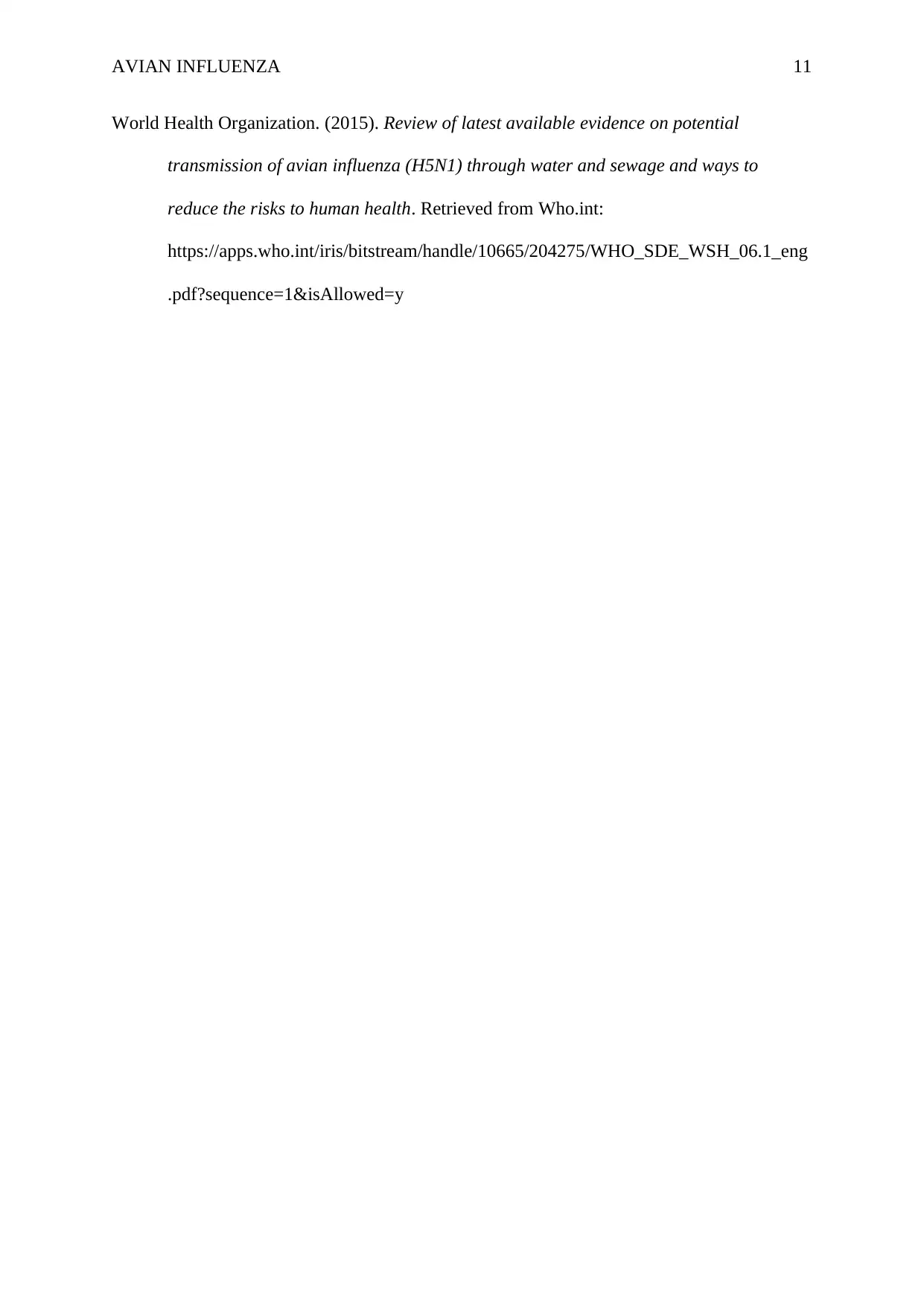
AVIAN INFLUENZA 11
World Health Organization. (2015). Review of latest available evidence on potential
transmission of avian influenza (H5N1) through water and sewage and ways to
reduce the risks to human health. Retrieved from Who.int:
https://apps.who.int/iris/bitstream/handle/10665/204275/WHO_SDE_WSH_06.1_eng
.pdf?sequence=1&isAllowed=y
World Health Organization. (2015). Review of latest available evidence on potential
transmission of avian influenza (H5N1) through water and sewage and ways to
reduce the risks to human health. Retrieved from Who.int:
https://apps.who.int/iris/bitstream/handle/10665/204275/WHO_SDE_WSH_06.1_eng
.pdf?sequence=1&isAllowed=y
1 out of 11
Related Documents
Your All-in-One AI-Powered Toolkit for Academic Success.
+13062052269
info@desklib.com
Available 24*7 on WhatsApp / Email
![[object Object]](/_next/static/media/star-bottom.7253800d.svg)
Unlock your academic potential
Copyright © 2020–2025 A2Z Services. All Rights Reserved. Developed and managed by ZUCOL.





